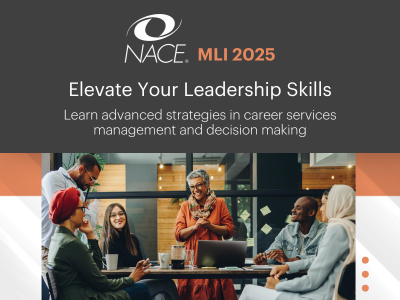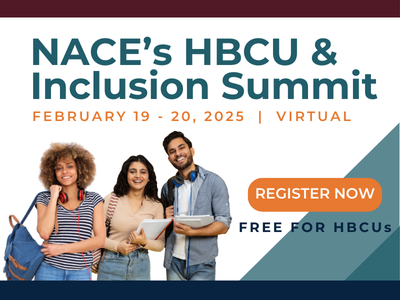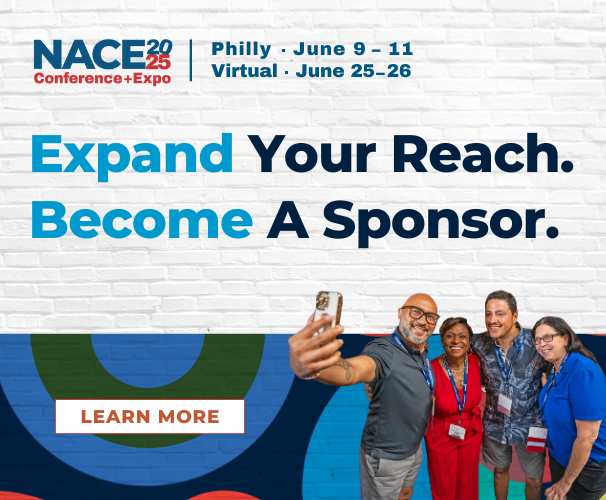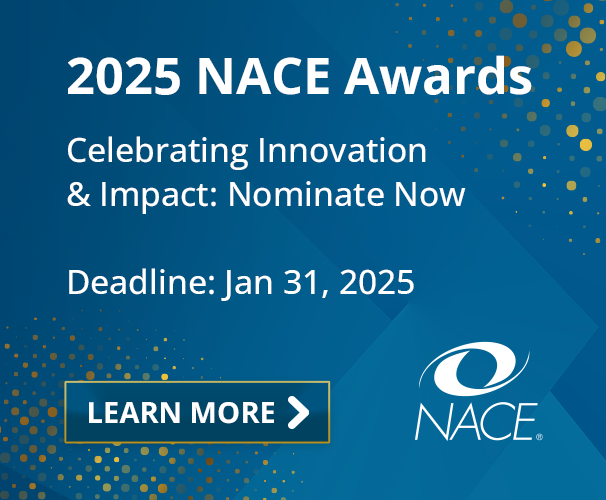NACE Journal, May 2017
The Case for Change
So much about both the world of work and our students has fundamentally changed in recent years. Rapidly evolving technology, a more fragmented job market, and generational differences have redefined career management for today’s college students. Most importantly, this generation of students is seeking opportunities and experiences through which they feel they can make a difference in the world. They care deeply about meaning, purpose, and happiness at work.
In The Art of Happiness at Work, the Dalai Lama and Howard C. Cutler offer a simple, three-part framework for what motivates each of us to work throughout our lives. The first category, which covers the vast majority of the world, is job, work that is primarily for the acquisition of resources. Many university graduates fall into the second category, career, which is work motivated by advancement, recognition, and status. The authors posit a third category that they believe all of us should be aspiring to, which they describe as calling. Calling is work that is motivated by a sense of personal mission and engagement, and finds the perfect intersection between what we are most passionate about and the situations that bring out the best in us.
Princeton University had one of the nation’s first university career centers, established in 1912 as the Self-Help Bureau. While much has changed in the past 100 years, the term “self-help” in today’s modern career development might imply self-creation. In 2013, when Princeton University embarked on a structural reimagining of the career center, there were several compelling opportunities to drive change and innovation in the ways we’re encouraging students to actively create or design their own careers and their lives.
First was the opportunity to shift our model from a transactional focus of helping students find jobs to a transformative focus of helping our students find themselves and how they want to engage with the world. A shift of this nature would not only enable us to address generational trends but also build a bridge to the liberal arts values of Princeton and implement a true four-year model of student career development.
Second, we had the opportunity to unlock the deep commitment of Princeton’s community, and particularly our alumni, parents, faculty, and staff, to support the process of exploration, reflection, and synthesis that we sought to catalyze across our student population. By innovating how we engage alumni and parents in supporting our students with the exploration process, we could also empower our students to build the networks that would support their later job searches.
Third was the opportunity to proactively create a broader and more diverse range of experiential opportunities, internships, and full-time jobs to meet the unique and evolving interests of our students. With new technology, we could source and deliver opportunities and facilitate connections that match students’ interests in deeply personalized ways.
Finally, we had the opportunity to redesign every aspect of our operations, systems, and processes with the voice of our students at the center of our decision-making.
A Strong Vision and Mission
Every change process needs to begin with a strong vision, mission, and strategy. We began by creating a new mission statement for our organization that was central to our theory of change: “We help each of our students define a unique and compelling career and life vision, and then connect them in personalized, multi-dimensional ways to the resources, people, organizations, and opportunities that will help make their unique visions a reality.” Embedded in that mission statement are themes of personalization, exploration, and connection. Rather than focus solely on obtaining their first job after graduation, our vision is “to empower Princetonians to proactively design their careers and lives in ways that help them align with meaningful opportunities across their lifetime.”
Our strategic objectives for the reimagining of our career center include:
- Catalyze hypothesis-driven self-reflection and the intentional, personalized exploration of the topic of meaningful work;
- Foster substantive engagement between each student and the broader Princeton community, including alumni, to support the process of career exploration and connections;
- Use students’ evolving interests to guide outreach efforts and source a more diverse range of internship and full-time opportunities;
- Create a student-focused and student-responsive culture and a transformative career center experience.
The Career and Life Vision Philosophy
At the heart of our reimagining is a core philosophy that guides all our interactions with students. The Career and Life Vision philosophy proposes a robust framework of hypothesis-driven self-reflection. As we engage with our students, we encourage them to begin framing meaningful questions about themselves that will guide the decisions in front of them. We then introduce them to concepts and frameworks that help them use the academic, extracurricular, experiential, and social aspects of the Princeton experience as a laboratory to answer those questions, surface new questions, and begin developing an evolving view of how they want to engage with the world.
This philosophy is inherent in the primary Career and Life Vision workshop that has been attended by several thousand members of the Princeton community since its launch in 2014.1 Additionally, we have fully integrated this philosophy and established a common set of learning outcomes for all of our career advising, career education, employer, and alumni engagement programs that revolve around the fundamental tenets of self-reflection, exploration, synthesis, iteration, and agency.
The success of the Career and Life Vision workshop has been integral to the broader success of our reimagining process. In anonymous surveys, participants often describe the program as “inspiring,” “transformative,” and “life-changing,” and testimonials have both driven thousands of attendees to the program and also dramatically improved our office’s engagement of first years and sophomores. In addition, many faculty, staff, and alumni have taken the program, which is helping us to influence how the Princeton community talks about careers.
Creating a Culture of Innovation
To support large-scale innovation and continuous improvement, we shifted from a hierarchical, top-down leadership structure to a more collaborative, team-based culture. The first step in changing the culture was having the team develop a set of guiding principles for our organization and adopting new attitudes, mindsets, values, and norms.
Two of the guiding principles, in particular, empowered staff to become intrapreneurs and change agents: “We respect and are inspired by the creative process and a ‘culture of yes’ where we dream big and work with an entrepreneurial spirit to support the organizational mission and guide our students” and “Failure and risk are acknowledged as natural parts of innovation.”
By investing in the personal and professional development of our staff and recognizing their individual strengths and passions, we were also able to promote or reclassify more than two-thirds of our team within two years. We also restructured roles, creating many new positions that didn't exist before, and nearly doubled the size of our organization with the addition of several term positions.
Regardless of their position, team members at every level of the organization have a student-facing role to ensure we all stay connected and responsive to the needs of our primary constituency, and see the world through their eyes.
Applying Design Thinking and Lean Startup Principles
To create innovative solutions based on deeper insights and empathy for the needs of all constituents, we applied creative problem-solving techniques using both design thinking and lean startup principles. Most importantly, we started with a “beginner’s mindset” and questioned all our old assumptions about what a career center should be.
Tim Brown, president and CEO of IDEO, defines design thinking as “a human-centered approach to innovation that draws from the designer's toolkit to integrate the needs of people, the possibilities of technology, and the requirements for business success.” While design thinking was inherent in our human-centric approach to change from the very beginning, we are fortunate to have a partnership with the Princeton University Keller Center for Innovation in Engineering Education. Members of the design thinking faculty have led workshops and provided guidance for our entire staff to deepen our knowledge of specific tactics we could apply to our strategic objectives. We developed cross-functional teams that included stakeholders, conducted qualitative interviews, created empathy maps, wrote problem statements, and used a broad-to-narrow approach to ideation. Input gathered from all stakeholders helped inform our perspective of the user experience and different user journeys, and we used this to reimagine how we interact with students—both in person and online.
An early example of this was incorporating students, employers, and campus partners in the selection of a new technology platform. We involved stakeholders in the evaluation of products and demos with vendors so they could ask questions, engage in the decision-making process, and offer suggestions for potential product customizations based on their user experience. Beyond building something new that would speak to the experience of our stakeholders, this participative problem-solving approach had many valuable by-products. It created buy-in and shared ownership of the decision and fundamentally de-risked the process of change.
Student input in our decision-making and involvement as co-creators has been critical. In the first year of our change process, we were approached by a group of design thinking students who wanted to use career services as the subject of their project. They conducted ethnographic research via student interviews and posts on Yik Yak and learned that freshmen and sophomores wanted more opportunities to pause and reflect on their future, and more peer-to-peer and alumni mentors—as well as a more-personalized approach and tailored resources that met their interests. Coincidentally, these insights were well-aligned with our strategic objectives, but, more importantly, the students created and tested several prototypes for early engagement programs that we were able to partner with them to emulate that fall during freshman orientation.
During the summer of 2016, we sponsored a student project team as part of the Princeton University Keller Center’s Tiger Challenge program. They came up with several concepts for a system to help students capture self-learnings throughout their Princeton journey. (See Figure 1.)
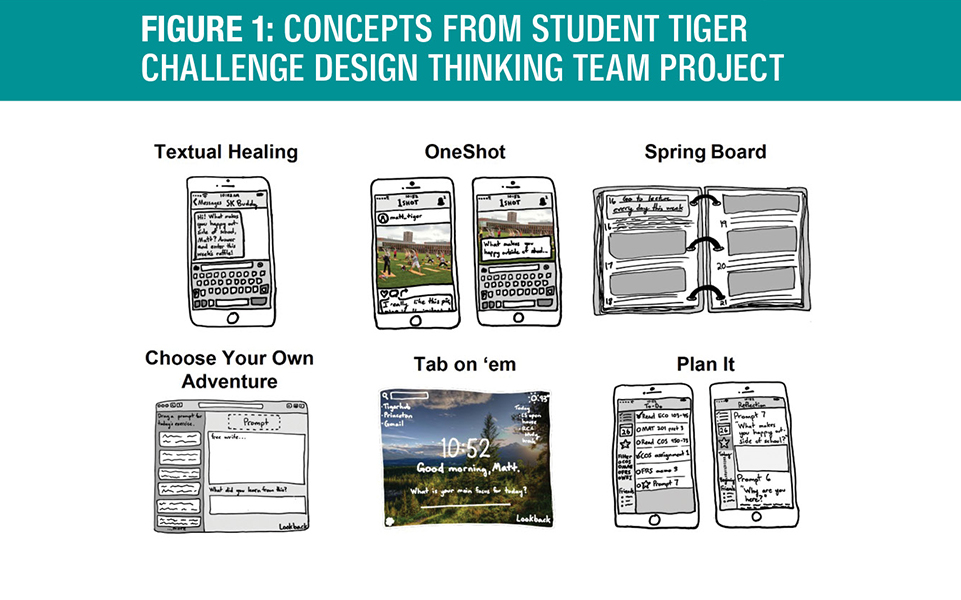
Another example of our application of design thinking principles is our new "Design Your Future: Mini-Course for Graduate Students," launched in spring 2017. This mini-course is based on the framework developed by Bill Burnett and Dave Evans in their book, Designing Your Life, our Career and Life Vision model, design thinking, as well as entrepreneurship methodologies, and offers graduate students a way to create career and life paths that are both fulfilling and viable by re-framing the career exploration process from a "choosing" endeavor to a "creating" endeavor.
BUILDING RELATIONSHIPS AND NETWORKS
We recognize that exploration cannot happen in a vacuum, and one of the great strengths of Princeton is how committed its alumni, faculty, staff, and parent communities are to support current students. Leveraging a community-wide approach to career development, we have designed a framework for student-alumni engagement that includes three levels of connection between students and alumni on and off campus, as well as online.
We began with a focus on programs that would develop systematic contact between students and alumni, created curated networks of alumni advocates and mentors using multiple platforms, and added systems where more organic connections and interaction can form.
Philosophically, we have tried to move toward a philosophy of point mentorship, where we expose all students to a broad range of alumni and professionals, seeding many great first conversations with the faith that longer-term mentorship relationships would follow more organically.
Our primary goal for all our programs is to make student-alumni engagement a constant, omnipresent part of the Princeton student experience. Examples of ways we are establishing systematic contact between students and alumni include:
- Replacing our traditional career fairs with meetups that bring students, alumni, and recruiters from organizations in high-interest industries together on and off campus. By involving alumni, using proactive outreach to industries of high interest to our students and a “by invitation only” approach, these events increase the value of the interactions for both students and employers.
- Expanding our Princeternship program, a legacy program that allows our students to spend winter and spring breaks shadowing alumni in their places of work and shifting the emphasis to freshmen and sophomores who are beginning the career exploration process.
- Expanding our Princeton in Washington program, another legacy program that brings students together with Princeton supporters in government and nonprofits, by offering more career education talks, site visits as well as recruiting events. Recent speakers include high-profile alumni and special guests like Justice Elena Kagan ‘81; David Petraeus, M.P.A. ’85, Ph.D. ’87; Robert Mueller ‘66; Chris Lu ‘88; Donald Rumsfeld ‘54; Cory Booker; and Ben Bernanke.
- Designing cross-generational networking events by class year that leverage the Princeton tradition of the assigning each incoming class an “alumni family.” Each class has a “sibling” (senior by five years), “parent” (senior by 25 years) and “grandparent” (senior by 50 years) class, and networking events offer the perspective of those early in their career and mid-career as well as the wisdom and support of those with a lifetime of career experiences to share.
- Hosting new Meet Princeton events around the country in partnership with regional alumni clubs to cultivate new employer relationships and promote recruitment of Princeton students to alumni and employers in regions and industries that are of high interest to students.
With respect to the formation of curated networks and organic connections, we are using multiple social platforms, including LinkedIn, Twitter, and Facebook, as well as chat-based messaging platforms.
In 2015, we launched the Tiger Career Community, a curated network of alumni, parents, faculty, and staff advocates who volunteer to provide advice and mentorship via online and on-campus events and programs. The program slogan is “Career development is complicated. Community makes it simpler.” Presently, there are more than 1,000 members in our Tiger Career Community LinkedIn group.
We have hosted Tiger Career Community networking events during reunions and are also coordinating virtual events using chat-based messaging platforms to spark conversations and connections between students and alumni across industries and the world. For example, we have launched a series of “Global Connections” events featuring alumni, employers, and graduate school representatives offering advice to students who are interested in exploring professional, educational, and volunteer opportunities outside of the United States.
We are establishing global hubs and a committed network of influencers, advocates, and connectors across multiple industries to serve as aspirational examples that fully reflect the diversity of paths available to liberal arts graduates. An explicit goal of the Tiger Career Community is to make Princeton’s alumni base equally available to all students, especially those from diverse, first-generation, and low socio-economic backgrounds.
Diversity, Equity, and Inclusion Initiatives
Poet Lemn Sissay, chancellor of the University of Manchester, offered a wonderful framework for diversity, equity, and inclusion within the context of higher education: “Open all minds. Open all dreams. Open all doors.” (YouTube, 2015.) This underscores the importance of creating inclusive communities and networks, and equitable access to opportunities for all students.
Princeton’s no-loan financial aid program is recognized as one of the most generous in the country and reflects the institution's commitment to equality of opportunity. This ensures a continued and growing enrollment of a diverse group of students from all socio-economic backgrounds. We have worked closely with student organizations and campus partners to create new initiatives that meet the unique and evolving needs of underrepresented students.
Of the more than 200 programs and events facilitated by our office during 2016, almost 60 were specifically tailored for these populations. Examples of events and initiatives underway include:
- The “Dinner with 12 Tigers” series, featuring alumni from underrepresented, first-generation, or low-income backgrounds sharing their experiences and advice over a more-intimate dinner conversation with around a dozen students;
- The Tiger Threads initiative, a lending and education program to meet the needs of first-generation and low-income students who often do not have access to interview attire;
- Conducting research to identify organizations that have been recognized for their diversity and inclusion programs and proactively cultivate recruiting relationships;
- Hosting our first-ever Diversity Meetup, which brought together more than 250 students, employers, and alumni for conversations about programs and practices that support and encourage diversity, equity, and inclusion in the workplace.
Taking a university-wide approach is inherent in our strategy of building relationships and networks for all students; the use of social media and multiple social platforms is another critical component.
Facilitating Social Networking on a University-Wide Scale
Recognizing that all our stakeholders are active partners in building and cultivating networks, facilitating conversations and connections, and creating access to meaningful opportunities for our students, we applied design thinking to create two large scale university-wide efforts involving social media. The first is the development of a mobile, chat-based social networking platform for students, alumni, and faculty. The second is Princeton Social Media Day, a campus-wide professional development effort to help students, faculty, staff, and alumni better leverage social media. Both of these initiatives support our mission to help students navigate the career exploration process—and to use social media in telling their story, pursuing their passions, building their brand, and expanding their connections.
Since 2015, we have led an effort to develop and launch a new chat-based social networking platform for the university community; this is meant to complement our more traditional alumni directory. Set to launch in spring 2017, this platform will enable groups to form fluidly based on shared affiliations, shared experiences, shared interests, and shared intent, and will allow conversations to happen informally and with social media norms.
We have built coalitions and partnerships across the university, including with our Office of Alumni Affairs, Office of Development, and several trustees, to help surface and solve issues around policy, governance, and technology. Experts, including our faculty in design thinking, are helping us to navigate the design process. We are working with a startup partner in Silicon Valley to design the technology, and we have adopted lean startup methodology, with daily iteration on the product development process and incorporated feedback from stakeholders and users.
Students involved with the development process hope that the platform will give them a channel to have informal, ongoing conversation with our alumni and faculty, and that the norm will be a “business casual” platform for the Princeton community. The platform will help us achieve our goal of seeding many great first conversations between students and alumni. While much remains to be proven, we will learn a great deal in the coming months as the platform launches.
Given trends in social recruiting and the role of career services as a customized connector, understanding how to leverage social media has become more critical than ever—not just for students but also for faculty, staff, and alumni. In December 2015, we spearheaded a campus-wide professional development conference called Princeton Social Media Day (#PUSocialDay); it was so well-received that we held the second one in March 2017.
This event was distinctive in the field of higher education in that the career center was leading the charge on social media education across the university—with the goal to collectively raise the bar on all of the ways our community used social media for personal and professional branding, and institutional storytelling.
We collaborated with student organizations, campus departments, alumni, and employers in designing a full-day of educational programming. This included talks and panels featuring experts from industry as well as leaders across campus and within our alumni community, on-demand profile “check-ups” by social media doctors, and free headshot photos. We planned the content to appeal to all levels of social media expertise, sharing best practices, tips, tools, and tactics—and practical ways that we could facilitate connections between members of the Princeton community.
Both quantitatively and qualitatively, the results of Social Media Day surpassed our expectations. In year one, we reached more than 1.4 million people and had 11.6 million impressions across just Twitter alone—and #PUSocialDay was trending in the United States and Scotland. Moreover, bringing the entire campus together helped us tap into the deep well of networks that already existed across Princeton’s ecosystem. Our unique approach to meeting the social media needs of multiple campus stakeholders was recognized nationally and internationally as a valuable model for other career centers.
Measuring the Success of Phase One of Our Reimagining
Our new model, strategy, and more personalized approach has not only changed perceptions of the career center among all stakeholders, but, most importantly, has influenced the career decision-making of our students.
We are seeing significant evidence that our model of hypothesis-driven exploration, reflection, and synthesis is having an impact. Our Career and Life Vision program has engaged several thousand members of the Princeton community, and feedback from participants consistently indicates that they would be very likely to recommend the program to a friend. The program has also received national media coverage and an invitation to create a MOOC version of the course that would be free and open to the world.
Additionally, we're seeing very strong student engagement with our office. In 2015, nearly 90 percent of the undergraduate student body engaged with us, including 84 percent of the freshman class. Engagement is even stronger this year, and we have already engaged more than 90 percent of the student body with just a few months left of the academic year.
The impact of our expanded student-alumni engagement efforts on the career decision making of the last two graduating classes has also been growing. The first year we assessed this, 12.2 percent of the Class of 2015 reported that connecting with alumni through career services influenced their career decision-making. For the Class of 2016, this doubled to nearly 24 percent.
By adopting a more collaborative, open, and inclusive stance, we are slowly building a movement and creating an army of advocates and partners in our change process. For example, in 2016, we doubled the number of alumni partnerships, with more than 400 alumni participating in programs, events, recruiting, and mentoring. Alumni have also become key influencers and champions for our employer outreach efforts within their industries and organizations.
Since early 2016, we have conducted proactive employer outreach to more than 700 organizations in a diverse range of industries; this has yielded hundreds of opportunities tailored to our students’ interests. We also established nearly 5,000 new employer relationships with the adoption of a new recruiting platform.
Since beginning our reimagining, we have established a strong sense of partnership with our students, alumni, and the broader university community, and this is reflected in our utilization, engagement, and satisfaction metrics, as well as qualitative feedback.
The Next Phase of Our Reimagining
“It seems like most of my friends who are upperclassmen see exciting opportunities coming through career services, and they really wish they were here their freshman and sophomore years,” said Justin Ziegler, the president of Princeton's Class of 2016, which was one of the first classes to experience our new model.
One of our primary goals since the beginning of our model change has been to achieve transformative rather than transactional impact. Princeton’s liberal arts mission encourages exploration and “the road less traveled.” Our new model has brought us closely in line with those institutional values, and, as a result, we have forged a bridge with the academic and co-curricular programs.
As we look forward to the next phase of our reimagining, our goals are to expand our Career and Life Vision program to a full four-year curriculum; to launch Princeton’s own social platform and help build a network of mentors, influencers, and advocates for students; to further leverage technology that focuses on social discovery rather than search; and to continue to widen the aperture of opportunities for our students. We also expect to rename our center in the near future to better evoke the unique elements of our model.
Our ultimate goal is that we can play an integral role in helping a generation of Princetonians find purpose and meaningful work—what the Dalai Lama describes as “calling.”
“One of the great things about where career services is going is that it’s really opening up opportunities for unique and diverse careers that are really compatible, personally, with my unique and diverse thoughts,” said Ziegler.
END NOTE
1 The Princeton Career and Life Vision program is based on an original model of hypothesis-driven exploration, reflection, and synthesis as described in this article. A workshop with the same title was previously taught by Andy Chan at the Stanford Graduate School of Business.
References
Brown, T. Retrieved from https://www.ideou.com/pages/design-thinking
Burnett, B. and Evans, D. (2016). Designing your life: how to build a well-lived, joyful life. New York: Alfred A. Knopf.
Byrne, J. (2011, January 11). Creating an eHarmony Model for MBA Careers. Retrieved from http://poetsandquants.com/2011/01/11/creating-an-eharmony-model-for-mba-careers/
“Career & Life Vision Conversations.” Retrieved from http://careerservices.princeton.edu/clvconversations
Connelly, L. (2014, April 2). A Career Change: A new direction for Career Services, with a message of self-exploration. Princeton Alumni Weekly, 12.Retrieved from https://paw.princeton.edu/issues/V114-N10
Garrison, Mark. “Top students turning down Wall Street life,” Marketplace, March 20, 2014. Retrieved from https://www.marketplace.org/2014/03/20/education/top-students-turning-down-wall-street-life
Jeong, J. (2017, February 14). New pop-up shop offers free business clothing to students. The Daily Princetonian. Retrieved from http://www.dailyprincetonian.com/article/2017/02/tiger-threads-pop-up-shop
Killian, S. and Steinhauer, R. “New mini-course for grad students offered by Career Services & the Keller Center.” Retrieved from https://careerservices.princeton.edu/new-mini-course-grad-students-offered-career-services-keller-center
Kitch, J. (2016, April 18). Choosing a Career Based on Passion. Interview with Pulin Sanghvi. Curious Conversations. Retrieved from https://curious.com/curiousconversations/choosing-a-career-based-on-passion
Korn, M. (2013, March 6). In Job Hunt, B-Schools Play Matchmaker. The Wall Street Journal. Retrieved from https://www.wsj.com/articles/SB10001424127887324539404578340460246473272
Kubu, E. (2016, January 9). “Social Media Resolutions for Higher Ed: Lessons Learned on #PUSocial Day,” LinkedIn Pulse. Retrieved from https://www.linkedin.com/pulse/social-media-resolutions-higher-ed-lessons-learned-pusocialday-kubu
Massar, C., & Johnson, C. (2016, May 2). Princeton Freshmen Seeking Career Help. Interview with Pulin Sanghvi. The Bloomberg Advantage Radio Podcast. Podcast retrieved from https://www.bloomberg.com/news/audio/2016-05-02/the-bloomberg-advantage-princeton-freshmen-seeking-career-help
Massar, C. & Johnson, C. (2016, December 7). Matching Education with Career Goals. Interview with Pulin Sanghvi. Bloomberg Markets Radio Podcast. Podcast retrieved from https://www.bloomberg.com/news/audio/2016-12-07/bloomberg-markets-matching-education-with-career-goals-audio
Princeton Alumni Weekly Staff (2015, February 4). “Cross-Generational Career Tips: Classes of ’66, ’91, and ’16 Gather for Networking Event.” Retrieved from https://paw.princeton.edu/article/cross-generational-career-tips-classes-%E2%80%9966-%E2%80%9991-and-%E2%80%9916-gather-networking-event
Ries, E. (2011). The lean startup: how today's entrepreneurs use continuous innovation to create radically successful businesses. New York: Crown Publishing.
Sissay, L. (2015, October 14). Inspire and Be Inspired. Retrieved from https://www.youtube.com/watch?v=WzZs1w3NWzg
Walter, D. (2015, December 2). The Creative Life. Princeton Alumni Weekly, 30. Retrieved from https://paw.princeton.edu/issues/V116-N05-12022015
Ziegler, J. (2015, July 21). Service and mentorship focus of Princeton-in-Washington’s landmark year. Retrieved from https://www.princeton.edu/news/2015/07/21/service-and-mentorship-focus-princeton-washingtons-landmark-year




